ASX Junior Takes First Mover Advantage in Largest Undrilled Onshore Oil & Gas Prospect in Africa
Hey! Looks like you have stumbled on the section of our website where we have archived articles from our old business model.
In 2019 the original founding team returned to run Next Investors, we changed our business model to only write about stocks we carefully research and are invested in for the long term.
The below articles were written under our previous business model. We have kept these articles online here for your reference.
Our new mission is to build a high performing ASX micro cap investment portfolio and share our research, analysis and investment strategy with our readers.
Click Here to View Latest Articles
With gas prices rising in tandem with the rampaging oil price, an ASX junior has bagged a dominant acreage position covering potentially the largest, seismically defined, undrilled hydrocarbon structure onshore Africa.
The company has a majority interest in 250,000 acres of highly prospective gas condensate territory in Africa’s Cabora Bassa Basin, Zimbabwe.
This is the largest discovery in 40 years and the largest undrilled prospect in Africa.
Today’s ASX junior has picked up an 80% interest in the Cabora Bassa Project, a gas-condensate exploration project and has just identified the potential for oil in their acreage too. The Cabora Bassa Basin has all the ingredients of a working petroleum system and the project comes with a robust dataset via a US$30 million spend by Mobil in the early 1990s, including seismic data.
Mobil — now US$344 billion-capped Exxon Mobil (NYSE:XOM) — was lured to the Cabora Bassa Basin in Zimbabwe in the early 1990s by the size and potential that had been identified by regional aeromagnetic surveys, which revealed thick sedimentary sequences within the rift basin.
Mobil identified and mapped the massive Mzarabani anticline in Africa, which has an area of more than 200 square kilometres, under closure, at favourable depths to host a conventional gas target.
The size of this target at over 200km2, is substantially bigger than the Waitsia Gas Field discovered by AWE in 2014 which was largest onshore gas discovery in Australia in 40 years. The Waitsia Gas Field is approximately 1 Tcf (trillion cubic feet) in size has an area of around 65km2 which shows the magnitude of the Mzarabani Prospect by comparison. The Mzarabani Prospect is also a stacked target with several prospective horizons that can be tested by a single well with multiple bites at the cherry.
Yet Mobil didn’t develop the project at the time, as it was focusing mainly on oil producing assets due to there being a lack of a structured market for gas in the African region.
The project is not unlike recent large discoveries in the region, displaying similar characteristics to prolific interior rift basin petroleum systems in Uganda, Kenya, South Sudan, Perth and Cooper-Eromanga basins.
This is an opportunity to secure first mover advantage and a dominant acreage position in the Cabora Bassa Basin and the company has planned a low-cost, high-impact work program to progress the prospect to farm-out or drill ready.
Besides the merits of the project itself, the timing couldn’t be any better.
Zimbabwe’s new President Emmerson Mnangagwa is welcoming foreign investment, declaring that “Zimbabwe is open for business”.
The new Zimbabwe Government and Ministry of Mines and Mining Development has signalled its desire to attract new foreign direct investment, particularly in the resources sector.
Also working in favour of the Cabora Bassa Project is the current Southern Africa power crisis and the lack of domestic energy security. The crisis is having a negative effect on growth in the region resulting in a huge push to adopt gas as an alternate energy source to coal.
An additional attraction is the fact that a recently appointed managing director of today’s company identified the project a decade ago and is a Zimbabwean national. The MD was attracted by the technical merits of the project, evident from extensive exploration previously undertaken by Mobil.
Since then the landscape has changed substantially with the potential for strong growth in domestic gas demand, as well as the prospect of exporting what could be a relatively low cost product into buoyant overseas markets.
And with the company due to release an independent prospective resource estimate this quarter, we could be seeing a potentially market moving development.
Introducing,

Invictus Energy Ltd (ASX:IVZ) is the company, Zimbabwe’s Cabora Bassa Basin is the location, and the size of the prize is anticipated to be in the multi-trillion cubic feet range.
As announced in mid-April, Interpose Holdings (now named Invictus Energy) acquired a 100% interest in Invictus Energy Resources along with an 80% interest and operatorship of the highly prospective Cabora Bassa Project, or Special Grant 4571 (SG 4571 permit).
The news was reported by Finfeed.com...
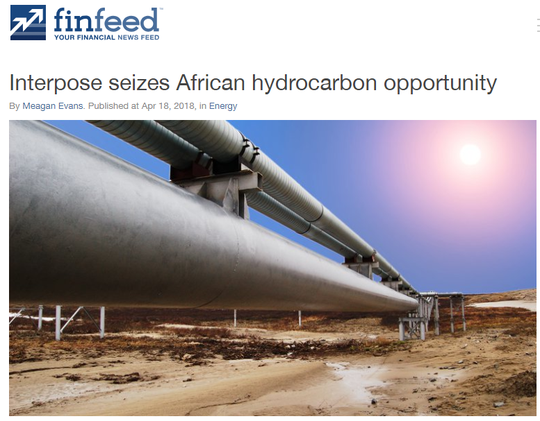
The project is located in the most prospective acreage in the Cabora Bassa Basin and includes the Mzarabani prospect.
As mentioned, the project was mapped extensively by Mobil in the early 1990s and studies concluded that the prospect contains conventional gas-condensate reservoir properties. This knowledge provides IVZ with a decided advantage as it determines a targeted drilling campaign. Importantly, Invictus’ Country Manager, Brent Barber, ran the exploration program for Mobil back then and has a long history with the project.
The project is close to existing pipeline infrastructure for the domestic and export markets. It is located in a non-farming area on state land, just two hours from the capital, Harare by road, having excellent access with dual lane tarmac all the way to the permit.
Such is the confidence around the Mzarabani prospect that a $4.5 million capital raising to fund IVZ’s exploration pursuits was heavily oversubscribed and managed by Ashanti Capital.
The funds will go towards a focused exploration program on the Cabora Bassa Project, including:
- Reprocessing of the gravity and aeromagnetic data and 1990s vintage Mobil 2D seismic.
- Conducting an environmental impact assessment study; funding third party independent resource certification.
- Beginning preparations for drilling the first exploration well in the basin.
Here’s IVZ’s proposed use of funds over the first two years.
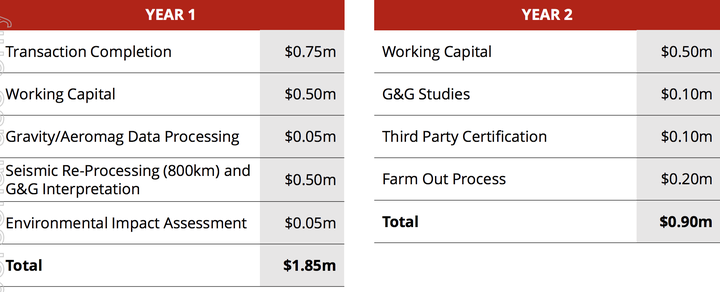
As indicated in the share price chart below, the news released in April was well received with the stock rallying more than 100% post acquisition.
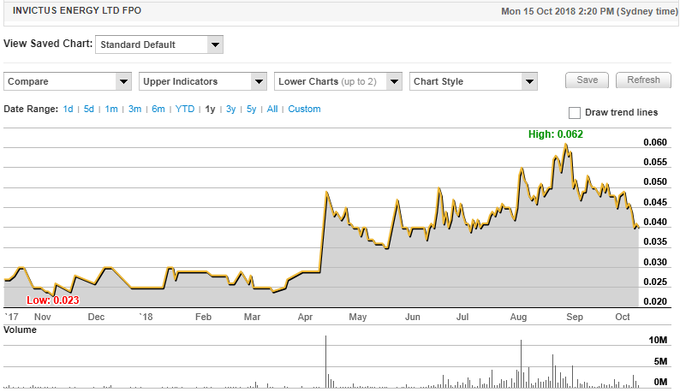
Momentum was sustained through to September with the company’s shares hitting a high of 6.2 cents.
It has pulled back some since then as negative sentiment in the world markets and IVZ’s share price has fallen in tandem. However, this is mainly a function of broader global volatility associated more with politics rather the oil and gas environment.
Activity heating up in regional areas
There is significant regional activity underway in the oil and gas space as Karoo aged rift plays gain attention and regional license rounds have attracted established East African Rift players to this play type.
This is good for IVZ as near term activity and news flow from neighbours will enhance the value of the Cabora Bassa Project and could provide share price momentum.
It’s a highly prospective region that is shaping up as a compelling destination for energy companies. It already hosts numerous big-name multinationals including Shell and ExxonMobil, plus many others as can be seen on the map below:
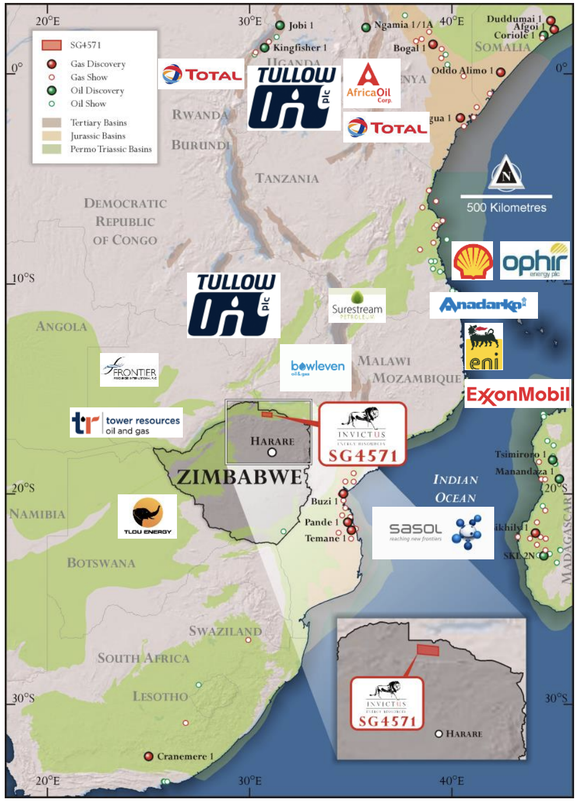
Yet IVZ has something that its peers don’t and that’s first mover advantage in the Cabora Bassa Basin portion of the greater Zambezi Valley rift play that extends from Namibia, through Botswana, Zambia and Zimbabwe, into Mozambique.
The company secured what’s widely believed to be the most prospective acreage in the basin, as well as the extensive legacy data set.
First-hand knowledge of Mzarabani
The quality of the asset was endorsed by newly appointed Managing Director, Scott Macmillan who identified the project nearly a decade ago.
Macmillan is a Zimbabwean national and reservoir engineer with 12 years’ experience in oil and gas.
He was previously the business advisor in the Global New Ventures group for $31 billion-capped Woodside Petroleum (ASX:WPL), which focused on African exploration and the Senior Reservoir Engineer for AWE Ltd, responsible for the Waitsia Gas Field development in Western Australia which was the crown jewel in AWE’s portfolio and which resulted in the takeover of AWE by Mitsui for $600 million.
During Mobil’s exploration phase, it identified and mapped the massive Mzarabani anticline, which has an area of over 200 square kilometres under closure, at favourable depths to host a conventional gas target.
This makes the Mzarabani potentially the largest undrilled structure in onshore Africa and a highly attractive exploration project.
Mobil was searching for big oil targets and spent US$30 million acquiring surface and subsurface data, including gravity surveys and over 1400 line kilometres of 2D seismic data. Their studies determined that the Cabora Bassa Basin has all the required ingredients of a working petroleum system and concluded that the Mzarabani Prospect contains conventional gas-condensate reservoir properties.
Here’s a summary of those findings:
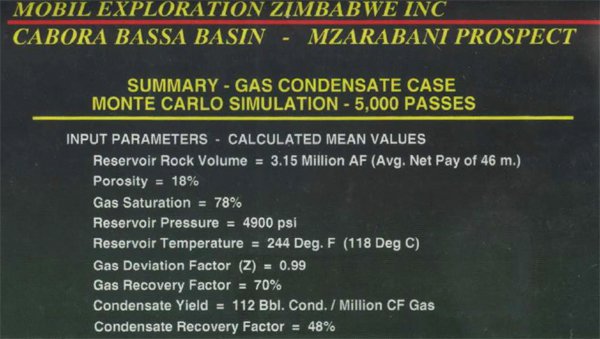
To realise the project’s potential, IVZ is undertaking a low-cost, yet high-impact work program to progress the prospect to farm-out or a drill ready stage.
Interestingly, the Mobil data that is now in the company’s hands has not previously been available in the public domain, possibly another reason why such a highly prospective area has gone unnoticed as Zimbabwe has been off investors’ radars until now.
The following shows the proposed Mzarabani-1 well which will be targeting multiple horizons.
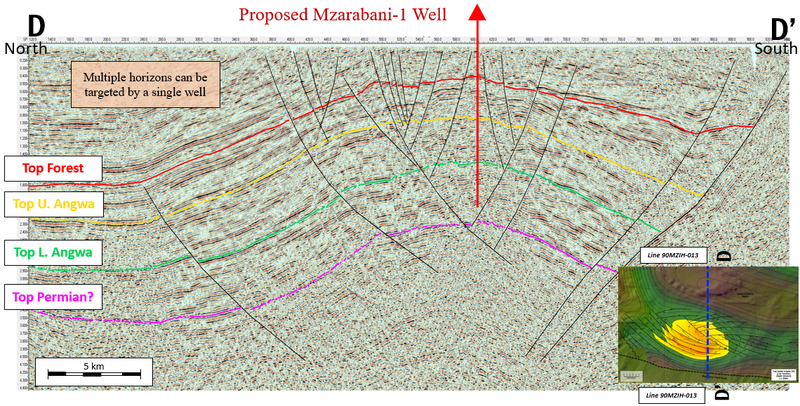
Modelling confirms oil potential
The first news flow regarding IVZ’s basin modelling and geochemical study emerged in late September with the company confirming the oil potential of the Cabora Bassa Basin.
Additionally, preliminary gravity data reprocessing also confirmed the shallow basement trend associated with the massive Mzarabani anticline.
While there were some important and valuable takeaways in the release, the news unfortunately coincided with a downturn in the oil price.
After a quick 10% rally on the back of this news, broader negative sentiment in equities markets wiped those gains. That said, IVZ is a long-term play and there will be ample news to drive its share price, particularly over the next 12 months.
The basin modelling and source rock characterisation is one of the key pieces of work that significantly de-risks the charge timing and availability to the Mzarabani Prospect and the wider basin as well.
In addition, new processing techniques applied to the raw datasets that were not available 25 years ago are beginning to show additional structural detail in the basin that was not previously possible as indicated by the preliminary gravity processing results.
Key risks cut
The Basin Model further demonstrates a reduction in the key risk previously identified by Mobil relating to the timing of hydrocarbon charge and trap formation.
The modelling also implemented and updated understanding of the thermal regime and burial depth history which is a key control of the hydrocarbon phase generation (oil or gas) for this source rock type.
Management said that the Basin Model will be updated once the final 2D seismic dataset has been reprocessed and reinterpreted which is expected towards the end of the December quarter.
The preliminary gravity data reprocessing also revealed that subtle north-west/south-east features enhanced within the south-west of SG 4571 that are obscured by larger features such as the Mzarabani structure are present. These features were unable to be mapped previously due to the seismic line spacing.
However, the new reprocessed gravity data along with the aeromagnetic data will assist in the seismic data interpretation in between the 2D seismic lines and are expected to potentially delineate further leads within the basin.
Gas projects central to a competitive manufacturing industry
For some years South Africa has been attempting to ramp up its manufacturing industry, an industry segment that could be highly competitive due to comparatively low wage costs in Africa.
However, one of the key hurdles has been access to an economical and reliable power supply.
South African cities and provinces have had a frustratingly long wait for the delivery of a reliable source of power from both a residential and industrial perspective, and had been highly reliant on coal-fired power generation.
But there’s now a substantial push to adopt gas as an alternate energy source to coal, both from an environmental and economic perspective.
Neighbouring areas delivering sizeable discoveries
There have been numerous oil discoveries in Ethiopia, Somalia and Madagascar. As part of the world-renowned Karoo Basin Supergroup, discoveries in the regional Karoo Basin are considered highly positive for Mzarabani.
Ethiopia is also host to the 2.2 trillion cubic feet Calub gas field, an area that has gained significant interest over the last 12 months.
State minister for mines, petroleum and natural gas in the Federal Democratic Republic of Ethiopia, Dr Koang Tutlam noted in March that Poly-GCL had discovered additional gas reserves in the Calub gas field.
Tutlam revealed to The Reporter, an independent Ethiopian media organisation, that the appraisal wells drilled by the company around Calub indicated the recoverable gas could be between six trillion cubic feet and eight trillion cubic feet.
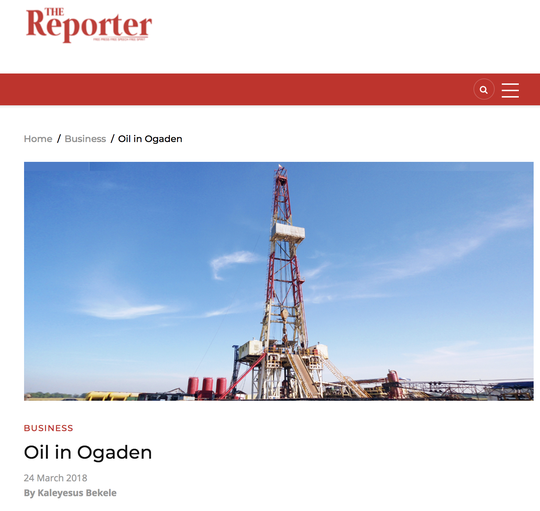
Quest for economic growth and stability sways political policy
The political environment has changed in many African countries with key catalysts being the need for a reliable power supply, as well as recognition of the correlation between power generation per capita and economic growth.
This has long been recognised throughout large manufacturing hubs such as Germany, China and the US.
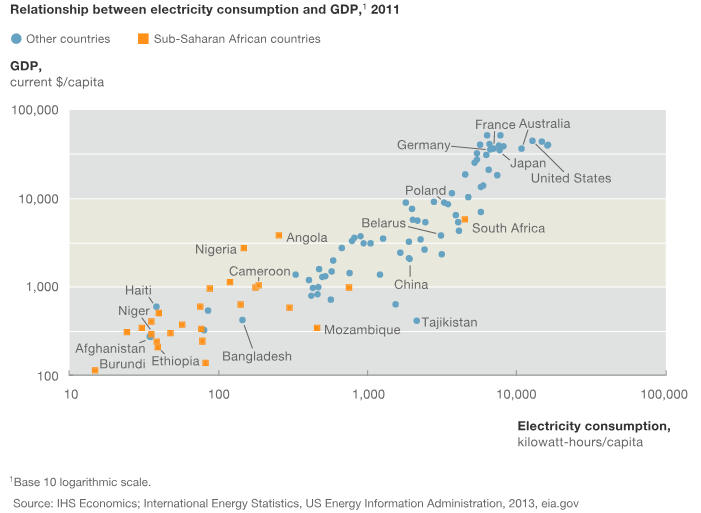
Furthermore, emerging economies such as India have become increasingly cognisant of the need to boost energy generation in order to support a burgeoning manufacturing industry, and the government has acted accordingly.
Until three years ago areas such as the Karoo Basin were not being tapped into. A look at a report produced by management consulting group McKinsey during that period, exposes some interesting data regarding African energy usage.
Here is the full report:
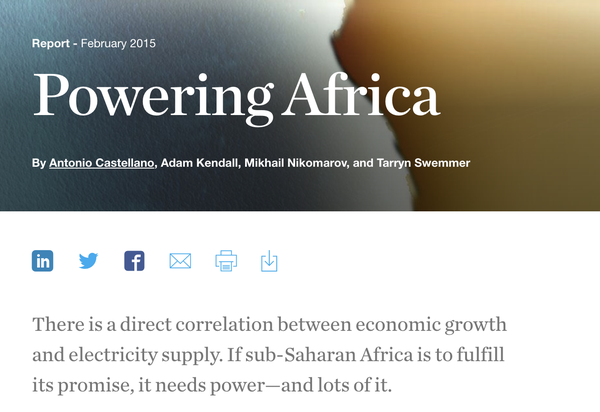
Having stressed the unequivocal link between power generation and economic development, McKinsey noted that from an electricity access point of view sub-Saharan Africa’s situation was the world’s worst.
Back in 2015, Africa had 13% of the world’s population, but was home to 48% of the global population that was without access to electricity. In fact, in only seven African countries more than half the population had electricity, with the rest of the continent having an average grid access rate of just 20%.
That all adds up to almost 600 million people in sub-Saharan Africa having no access to electricity.
The following demonstrates the substantial imbalance in consumption per capita compared with other global regions.
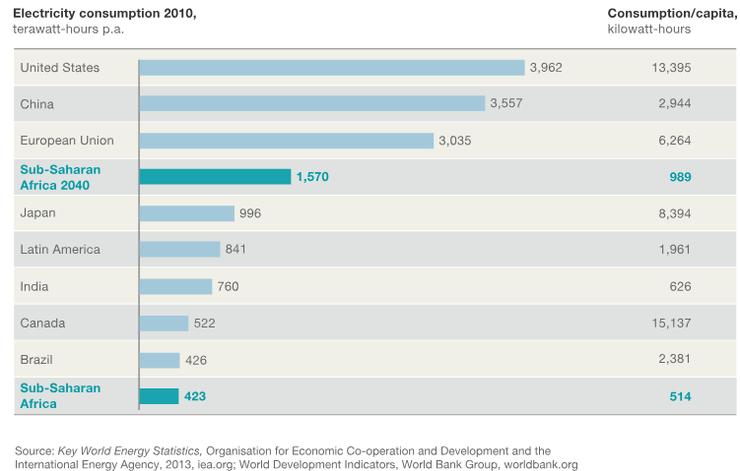
This data is significant for a company in IVZ’s position, as the massive development required to bring gas projects on stream and establish associated infrastructure will take many years.
Furthermore, this suggests resistance to onshore oil and gas development will dissipate given that the clock is already ticking.
The story gets better if McKinsey is on the mark, as gas will account for more than 40% of the electricity generated from 2020 onwards. And while solar power will be important, it’s not expected to take off significantly until after 2030 and even then it will provide just a small share, highlighting the continued reliance on gas.
Consequently, the timing of the Mzarabani development couldn’t be better.
McKinsey hit the nail on the head, and in doing so reflected the sentiments of IVZ’s management as it articulated ways to facilitate the development of the power generation sector.
McKinsey said: “Regional integration, such as power pools, and promotion of renewable generation are game changers that could shape the energy landscape in sub-Saharan Africa over the next 25 years.”
“We found that significantly increasing regional integration could save more than $40 billion in capital spending, and save the African consumer nearly $10 billion per year by 2040, as the levelised cost of energy falls from $70 per megawatt-hour to $64 per megawatt-hour.
“Higher levels of integration would result in larger regional gas options being favoured over some of the smaller in-country solar and wind additions.”
Government actively encourages new investment
Substantial new investment activity is underway in Zimbabwe, with the country’s new president, Emmerson Mnangagwa implementing several economic reforms.
By appointing an experienced mining industry executive as the Minister of Mines, he has demonstrated a commitment to understanding and supporting mining companies, including those operating in the energy sector.
Reforms include the allowance of 100% foreign ownership of assets and full remittance of earnings. While in some economic zones, developers will be provided with a five-year tax holiday and a 15% corporate tax rate thereafter.
From a broader perspective, support from the South African government for the development of shale gas projects in the Karoo region was confirmed in March last year.
Macmillan’s knowledge of Zimbabwe and the workings of the oil and gas industry in African countries will be invaluable in terms of progressing the project and gaining political support.
Some infrastructure is already in place for energy sharing, in particular the 865 kilometre gas pipeline that runs from Mozambique to South Africa.
However, it is expected that further independent power plant construction will allow electricity exports to any country within Southern Africa through the Southern Africa Power Pool.
Multiple end markets
IVZ has identified both existing and emerging gas distribution opportunities including the Hwange power station, the Pande-Temane gas pipeline to South Africa, the Sable ammonia plant and the Rovuma Basin LNG plants.
As indicated below, this mix of energy transport infrastructure and power hungry industrial projects are in close proximity to Zimbabwe.
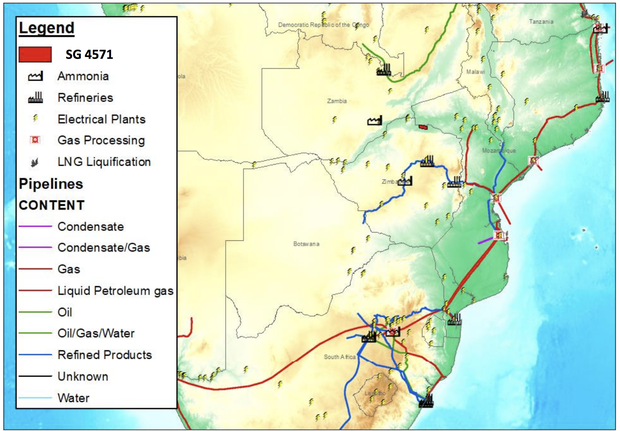
What’s next for IVZ?
While IVZ secured the most prospective acreage in the Cabora Bassa Basin, we can expect near term activity and news flow from neighbours to enhance the value of the project.
This acquisition, and its subsequent exploration, is a major step for IVZ as it assembles a quality portfolio of high potential assets, with low cost entry, that can be de-risked through technical work and farmed out on good terms.
The Basin Model will also be updated once the final 2D seismic dataset has been reprocessed and reinterpreted which is expected shortly together with a maiden independent prospective resource estimate due this quarter.
The new reprocessed gravity data, along with the aeromagnetic data, will assist in the seismic data interpretation in between the 2D seismic lines and could delineate further leads within the basin.
IVZ has its sights set on targeting multiple regional players for farm-out in 2019. With multiple regional players, including the cashed up aforementioned multinationals in relatively close proximity to Mzarabani, finding a joint venture partner or negotiating a farm in arrangement shouldn’t be difficult.
As IVZ says, “near term activity is low risk, low cost, but high value-add”. And we couldn’t ask for more from a small cap ASX explorer.
This information is general financial product advice only and you should consider seeking professional advice before making any investment decision. All indications of performance returns are historical and cannot be relied upon as an indicator for future performance.
General Information Only
This material has been prepared by StocksDigital. StocksDigital is an authorised representative (CAR 000433913) of 62 Consulting Pty Limited (ABN 88 664 809 303) (AFSL 548573).
This material is general advice only and is not an offer for the purchase or sale of any financial product or service. The material is not intended to provide you with personal financial or tax advice and does not take into account your personal objectives, financial situation or needs. Although we believe that the material is correct, no warranty of accuracy, reliability or completeness is given, except for liability under statute which cannot be excluded. Please note that past performance may not be indicative of future performance and that no guarantee of performance, the return of capital or a particular rate of return is given by 62C, StocksDigital, any of their related body corporates or any other person. To the maximum extent possible, 62C, StocksDigital, their related body corporates or any other person do not accept any liability for any statement in this material.
Conflicts of Interest Notice
S3 and its associated entities may hold investments in companies featured in its articles, including through being paid in the securities of the companies we provide commentary on. We disclose the securities held in relation to a particular company that we provide commentary on. Refer to our Disclosure Policy for information on our self-imposed trading blackouts, hold conditions and de-risking (sell conditions) which seek to mitigate against any potential conflicts of interest.
Publication Notice and Disclaimer
The information contained in this article is current as at the publication date. At the time of publishing, the information contained in this article is based on sources which are available in the public domain that we consider to be reliable, and our own analysis of those sources. The views of the author may not reflect the views of the AFSL holder. Any decision by you to purchase securities in the companies featured in this article should be done so after you have sought your own independent professional advice regarding this information and made your own inquiries as to the validity of any information in this article.
Any forward-looking statements contained in this article are not guarantees or predictions of future performance, and involve known and unknown risks, uncertainties and other factors, many of which are beyond our control, and which may cause actual results or performance of companies featured to differ materially from those expressed in the statements contained in this article. S3 cannot and does not give any assurance that the results or performance expressed or implied by any forward-looking statements contained in this article will actually occur and readers are cautioned not to put undue reliance on forward-looking statements.
This article may include references to our past investing performance. Past performance is not a reliable indicator of our future investing performance.

